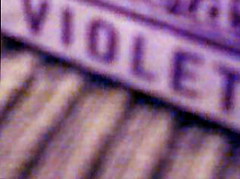A week or two ago, I listened to Karen Tongson from USC give a presentation ("listening party") on music and the suburbs. Last night, I attended a talk in which Alan Hess discussed the architecture of suburban Southern California. As a child of the suburbs and a student of 1950s culture, I found both talks fascinating.
The suburbs, like the 1950s in which they flourished, seem to be traditionally discussed with a mixture of derision and nostalgia. When you think about the suburbs, you think about white, middle-class, nuclear families living uniform lives in straight little rows. Of course, the minute you begin to look critically, that image dissolves, but it generally persists in the myths we tell ourselves anyway. This is perhaps what makes the discussion of suburban culture, particularly Southern Californian suburban culture, interesting. Art and design are a fascinating set of discussions because they have been so invisible. One assumes there is no design in the suburbs, that the houses all look the same. While there is an element of truth to this, Hess effectively argued for the virtuosity and variety of those planning the surburbs and their ranch houses in Southern California in the '50s. The Googie coffee shops and Cliff May ranch houses were precisely designed to fit a lifestyle and a mindset that were new and exciting in the 1950s, and not so different than what a lot of people still wish for today.
Tongson's work on race in the suburbs is particularly interesting, because I know I grew up with the image of the suburbs as depicted in A Raisin in the Sun: all white with the whole neighborhood getting disrupted by (gasp!) black people moving in. By the time I grew up in the suburbs, Southern California was pretty racially diverse and I grew up with friends who were Chinese and Taiwanese (I knew the difference!) and Japanese and Korean and Filipino and Indian. Nearby suburbs had large Chicano, Latino, and Middle-Eastern populations. While I haven't done any historical research to back this up, I rather suspect that even in the 1950s, Southern California had a very racially diverse population, and while I'm sure there was a great deal of neighborhood segregation, I wonder if the suburbs were ever as lily-white as we like to imagine them.
Tongson's talk on music in the suburbs was primarily focused on the late '80s and early '90s. She talked a lot about pop music, but it's also easy to imagine pop, punk, grunge, and other movements as the response of disaffected teenagers to the confines of growing up somewhere "safe" with nothing to do and nowhere to go in the evenings. But what were the suburbs like musically in the 1950s? We imagine teenagers listening to Elvis and other early Rock 'n' Roll and forming bands to play at high school dances a la Back to the Future, but how much of this image of accurate and how much of it is created by nostalgia? I know that my dad growing up was listening to The Beach Boys and my mom was listening to Mitch Miller and her parents' music from the '40s and '30s much like I grew up on music from the 1950s and '60s.
My mind, of course, turns to the theater. I can know exactly what people were watching on TV and in the movie theaters in the 1950s in Southern California, but were they seeing live performance? Was there theater to see? They were presumably buying the cast albums of Broadway musicals and seeing the stars appear on the Ed Sullivan show and doing shows in high schools. Were there even theaters for live shows in LA in the '50s? I know that the LA Music Center opened in 1964 and Gordon Davidson began working at the Taper in 1967. What comes before that? The Shrine Auditorium opened in 1926. Did it ever host anything besides awards shows and USC basketball? The Pantages Theater was opened in 1930 and originally hosted Vaudeville acts and movie screenings, but didn't do live theater until 1977. Did people from the suburbs come into LA to see shows? Did mid-level Hollywood stars appear in stage shows in LA as they occasionally do today? What is the theater of the suburbs? Is it Death of a Salesman and Our Town? National tours of Broadway musicals? Community theater?
Art
-
The Art section is the only one in the New York Times' culture pages that I
haven't written for — is my review of the Yasmina Reza show as close as I'm
g...
4 weeks ago

1 comments:
Hey, unrelated, but are you aware of the Concrete Folk Variations shows in Silver Lake? They're Sapphic L.A. Noir puppet shows...I think you might be interested.
www.manualarchives.org
Post a Comment